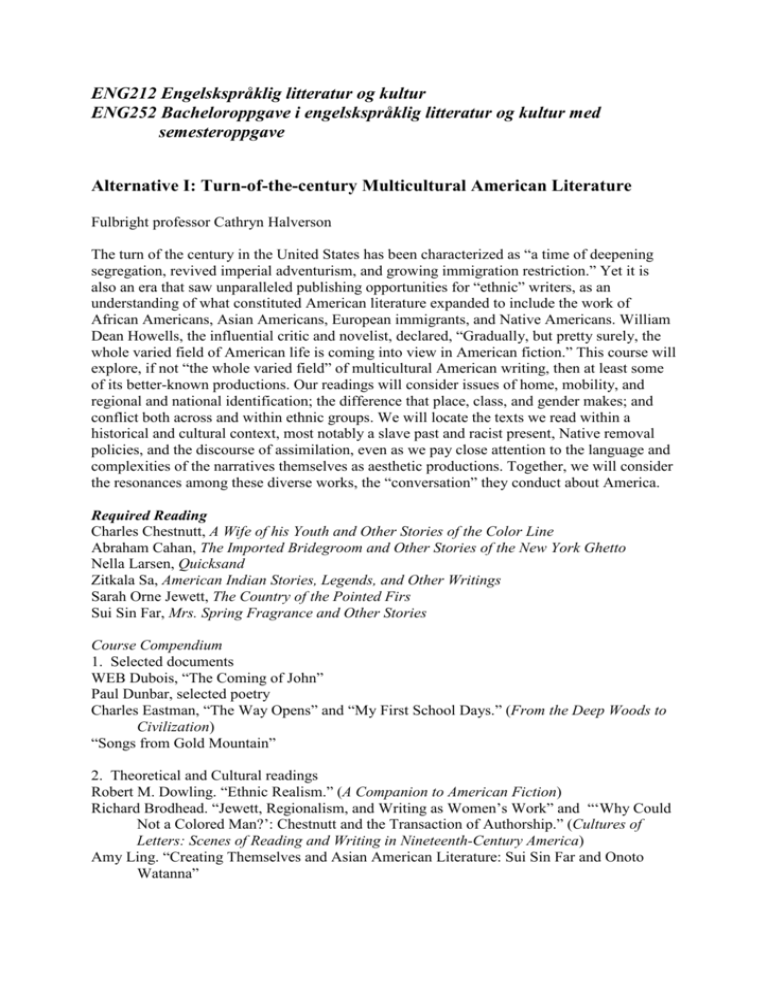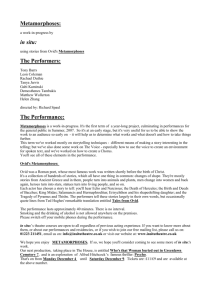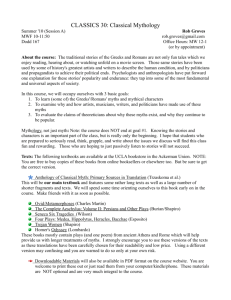ENG212 Engelskspråklig litteratur og kultur
advertisement

ENG212 Engelskspråklig litteratur og kultur ENG252 Bacheloroppgave i engelskspråklig litteratur og kultur med semesteroppgave Alternative I: Turn-of-the-century Multicultural American Literature Fulbright professor Cathryn Halverson The turn of the century in the United States has been characterized as “a time of deepening segregation, revived imperial adventurism, and growing immigration restriction.” Yet it is also an era that saw unparalleled publishing opportunities for “ethnic” writers, as an understanding of what constituted American literature expanded to include the work of African Americans, Asian Americans, European immigrants, and Native Americans. William Dean Howells, the influential critic and novelist, declared, “Gradually, but pretty surely, the whole varied field of American life is coming into view in American fiction.” This course will explore, if not “the whole varied field” of multicultural American writing, then at least some of its better-known productions. Our readings will consider issues of home, mobility, and regional and national identification; the difference that place, class, and gender makes; and conflict both across and within ethnic groups. We will locate the texts we read within a historical and cultural context, most notably a slave past and racist present, Native removal policies, and the discourse of assimilation, even as we pay close attention to the language and complexities of the narratives themselves as aesthetic productions. Together, we will consider the resonances among these diverse works, the “conversation” they conduct about America. Required Reading Charles Chestnutt, A Wife of his Youth and Other Stories of the Color Line Abraham Cahan, The Imported Bridegroom and Other Stories of the New York Ghetto Nella Larsen, Quicksand Zitkala Sa, American Indian Stories, Legends, and Other Writings Sarah Orne Jewett, The Country of the Pointed Firs Sui Sin Far, Mrs. Spring Fragrance and Other Stories Course Compendium 1. Selected documents WEB Dubois, “The Coming of John” Paul Dunbar, selected poetry Charles Eastman, “The Way Opens” and “My First School Days.” (From the Deep Woods to Civilization) “Songs from Gold Mountain” 2. Theoretical and Cultural readings Robert M. Dowling. “Ethnic Realism.” (A Companion to American Fiction) Richard Brodhead. “Jewett, Regionalism, and Writing as Women’s Work” and “‘Why Could Not a Colored Man?’: Chestnutt and the Transaction of Authorship.” (Cultures of Letters: Scenes of Reading and Writing in Nineteenth-Century America) Amy Ling. “Creating Themselves and Asian American Literature: Sui Sin Far and Onoto Watanna” Additional Texts for 300-level students James Weldon Johnson, The Autobiography of an Ex-Colored Man Kate Chopin, The Awakening Anzia Yezierska, “The Lost ‘Beautifulness’” Nella Larsen, Passing (recommended) Onoto Watanna, “An Unexpected Grandchild.” A. Robert Lee, “Epilogue: Fictions of Whiteness” (Multicultural American Literature) Alternative II: The Journey Motif in Literature or the Literary Journey ENG 212 / 252, spring 2009, Alternative II Thursdays 1215 - 1400 Sydnesplassen 12-13, Undervisningsrom 210 Heidi Silje Moen heidi.moen@if.uib.no In this course we will investigate a variety of texts that, however different, can be said to have one thing in common: the journey motif. The course will investigate various ways of thinking about journeys. Starting out with the Odyssey and the Metamorphoses and moving on to texts that are positioned in the uneasy territory between modernism and post-modernism will open up for comparisons and questions concerned with physical as well as psychologically transformative journeys. We will discuss the texts on the syllabus with a focus on structure, narrative, authority, and origins: what uses have been made of the journey motif; how is it brought out, and to what effects? To assist our understanding and reading of these literary journeys we will discuss some theorists’ thinking about narration. Required Reading *The texts with an asterisk are in the course compendium available at STUDIA. *Auerbach, Erich. “Odysseus’ Scar.” Bakhtin, M. M. “Epic and Novel.” *Brooks, Otis. “The Plan of Ovid’s Epic” *Robert Browning: “Childe Roland to the Dark Tower Came”. T. S. Eliot: The Waste Land / “Journey of the Magi”. Collected Poems 1909 – 1962. London, Boston: faber and faber, 1963. D.H. Lawrence. The Rainbow. Hertfordshire: Wordsworth Classics, 1995. Joseph Conrad. Heart of Darkness. Penguin Popular Classics, 1994. Samuel Beckett: Waiting for Godot. Second Edition. London, Boston: faber and faber, 1965. *Ezra Pound: Ends and Beginnings of The Cantos. David Malouf. An Imaginary Life (1978). Vintage, 1999. Derek Walcott: Omeros (1990). New York: Farrar, Straus and Giroux, 1992. Background / Reference Literature: Homer: The Odyssey. Translation and introduction by Richmond Lattimore. 2007. Ovid: Metamorphoses. Translation and introduction by Horace Gregory. 2001 Secondary Literature: Course Compendium Theoretical Reference Literature: Aristotle, Poetics. Trans. Richard Janko. Indianapolis: Hackett Publishing Company, 1987. Lothe, Jakob. Narrative in Fiction and Film. An Introduction. Oxford 2000. Brooks, Peter. “Reading for the Plot,” “Narrative Desire”. Reading for the Plot. Design and Intention in Narrative. Harvard UP, 1992. Preliminary Seminar Overview: 1: Homer: The Odyssey. 2: Ovid: Metamorphoses. 3: Robert Browning: “Childe Roland to the Dark Tower Came”. T. S. Eliot. “Journey of the Magi.” 4: T. S. Eliot: The Waste Land. 5: D.H. Lawrence: The Rainbow. 6: Joseph Conrad: Heart of Darkness. 7. Postmodern / postcolonial approaches 8: Samuel Beckett: Waiting for Godot. 9: Ezra Pound: Beginnings and Endings of The Cantos of Ezra Pound. 10: David Malouf: An Imaginary Life. 11: Derek Walcott: Omeros. 12: Summing up











